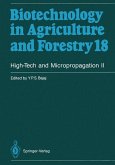The increasing use of biotechnology for the improvement of agricultural crop species has gained momentum, and recent developments (see Crops J) have shown beyond doubt the far-reaching implications of biotechnological approaches for future agricultural research and plant breeding programs. The production of novel plants and somaclones showing resistance to pests, diseases, herbicides, and salt and the early release of disease-free as well as improved cultivars have become reality. The present volume comprises 31 chapters and deals with the impor tance, distribution, conventional propagation, micropropagation, and methods for the in-vitro induction of genetic variability in various fruits, vegetables, grasses, and pasture crops such as grapes, strawberry, brambles, red raspberry, currants, gooseberry, kiwifruit, blueberry, cran berry, cauliflower, cabbage, brussels sprouts, broccoli, cucumber, chico ry, taro, rhubarb, lettuce, spinach, quinoa, kale, fescue, bromegrass, Ber mudagrass, napier grass, foxtail millet, turtle grass and others. (The cere als and other vegetable crops are discussed in Crops J, Vol. 2 of the series). Micropropagation of some fruit crops such as strawberry, grape, and raspberry is already being practiced on a large scale in various countries. Likewise, test-tube-derived plants of certain crops such as brassicas, let tuce, and taro and improved pastures are being utilized, while the technology for mass propagation of certain other crops is being worked out. These recent developments emphasize the urgent need to arouse awareness among horticultural scientists and plant breeders to enable them to incorporate these modern innovative approaches into routine crop improvement programs.
Hinweis: Dieser Artikel kann nur an eine deutsche Lieferadresse ausgeliefert werden.
Hinweis: Dieser Artikel kann nur an eine deutsche Lieferadresse ausgeliefert werden.








